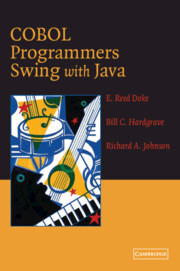Book contents
- Frontmatter
- Contents
- Preface
- Introduction
- Chapter 1 Why You Should Learn Java
- Chapter 2 An Introduction to Object-Oriented Programming
- Chapter 3 Java Structure
- Chapter 4 Defining Data
- Chapter 5 Computation
- Chapter 6 Decision Making
- Chapter 7 Loops
- Chapter 8 Arrays
- Chapter 9 Data Access
- Chapter 10 Graphical User Interfaces
- Chapter 11 Object-Oriented Development Issues
- Glossary
- Index
Chapter 4 - Defining Data
Published online by Cambridge University Press: 26 August 2009
- Frontmatter
- Contents
- Preface
- Introduction
- Chapter 1 Why You Should Learn Java
- Chapter 2 An Introduction to Object-Oriented Programming
- Chapter 3 Java Structure
- Chapter 4 Defining Data
- Chapter 5 Computation
- Chapter 6 Decision Making
- Chapter 7 Loops
- Chapter 8 Arrays
- Chapter 9 Data Access
- Chapter 10 Graphical User Interfaces
- Chapter 11 Object-Oriented Development Issues
- Glossary
- Index
Summary
OBJECTIVES
In this chapter you will study:
Defining Java data;
Java data types;
Variable scope;
Using literals;
Defining constants;
Changing data types; and
Using Java's String class.
In this chapter you will learn how to define data using Java. We will write data definition statements for alphanumeric, numeric, and boolean data (arrays are described and illustrated in Chapter 8). You will also see how to use a supplied Java class named String to simplify the definition and manipulation of alphanumeric data. You will also learn about the scope of variables. Scope determines which parts of your program can access a variable or method.
At the end of the chapter we will develop the complete data definition statements for the attributes of the Community National Bank classes developed in the previous chapter.
NOTES
COBOL uses the term data item or field.
Java uses the term variable.
In keeping with the spirit of Java, here we will use variable.
This chapter assumes you know about:
COBOL
Data division code
Picture clauses
Usage clause
Bits and bytes
Java
Object-oriented concepts (Chapter 2)
Java program structure (Chapter 3)
COBOL PICTURE CLAUSE
Those of us who write COBOL programs are accustomed to using the PICTURE clause to describe data items.
- Type
- Chapter
- Information
- COBOL Programmers Swing with Java , pp. 66 - 81Publisher: Cambridge University PressPrint publication year: 2004



